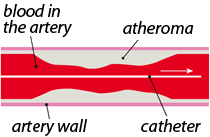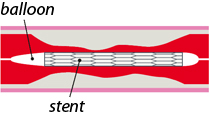A coronary angioplasty is a procedure to open up narrowed or blocked arteries that can be caused by coronary heart disease. This will allow blood to flow more easily and supply your heart muscle with enough oxygen.
You may need to have a coronary angioplasty to treat chest pain (angina), or if you have a heart attack. You can have an angioplasty as a planned procedure or as an emergency treatment, and you can have it more than once.
You’ll have an angiogram before your angioplasty to look inside your arteries and check where these blockages are and how much they’re blocked. An angiogram often happens as part of the same procedure.
An angioplasty normally takes between 30 minutes and two hours, although it can take longer.
At the start of the procedure you’ll be given a local anaesthetic to numb the area. Then a catheter – a fine, flexible, hollow tube – is passed into an artery in either your groin or your arm. At the tip of the catheter is a small inflatable balloon and a small tube of stainless steel mesh, called a stent.

Some dye (contrast) is injected into the catheter so that your arteries can be seen on an x-ray screen. This helps show where the narrowings in your arteries are, and how severe they are. It’s normal to feel a hot flushing sensation when the dye is injected.

The catheter is then passed up to your heart and into a coronary artery until its tip reaches a narrow or blocked section.

The balloon on the end of the catheter is then gently inflated so that it squashes the fatty deposits (the atheroma) against the artery wall, widening the artery.

As the balloon is inflated, the stent in place on the balloon expands so that it acts as a scaffold and holds open the artery. The balloon is deflated and removed, leaving the stent in place.
Some people may feel a palpitation, and you might feel some angina. If you feel unwell, or have pain at any time during the procedure, tell the team.
When the test is over, the catheters are removed. Sometimes there might be a small amount of bleeding when they’re taken out. A nurse or doctor will press on the area for a short while or they may put in a plug called an angioseal to stop any bleeding. After the procedure, you’ll need to stay in bed for a while.
In the first few hours afterwards you might get some chest discomfort. If this happens, tell the doctor or nurse.
How successful is coronary angioplasty?
In most cases the blood flow through the artery is improved. Many people find that their symptoms get better and they’re able to do more.
Sometimes the artery can become narrowed again, causing angina to return. But advances in stent technology mean that the risk of this happening is getting lower. Many people are now symptom-free for a long time.
A small number of people have complications. The risk varies depending on your overall health and your individual heart condition. Have a chat with your consultant about the benefits and possible risks of having an angioplasty and any concerns you may have.
